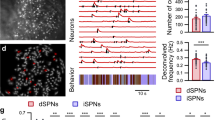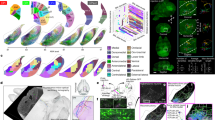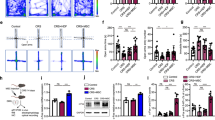Abstract
The striatum is the input structure of the basal ganglia network that contains heterogeneous neuronal populations, including two populations of projecting neurons called the medium spiny neurons (MSNs), and different types of interneurons. We developed a transgenic mouse model enabling inducible ablation of the striatonigral MSNs constituting the direct pathway by expressing the human diphtheria toxin (DT) receptor under the control of the Slc35d3 gene promoter, a gene enriched in striatonigral MSNs. DT injection into the striatum triggered selective elimination of the majority of striatonigral MSNs. DT-mediated ablation of striatonigral MSNs caused selective loss of cholinergic interneurons in the dorsal striatum but not in the ventral striatum (nucleus accumbens), suggesting a region-specific critical role of the direct pathway in striatal cholinergic neuron homeostasis. Mice with DT injection into the dorsal striatum showed altered basal and cocaine-induced locomotion and dramatic reduction of L-DOPA-induced dyskinesia in the parkinsonian condition. In addition, these mice exhibited reduced anxiety, revealing a role of the dorsal striatum in the modulation of behaviors involving an emotional component, behaviors generally associated with limbic structures. Altogether, these results highlight the implication of the direct striatonigral pathway in the regulation of heterogeneous functions from cell survival to regulation of motor and emotion-associated behaviors.
Similar content being viewed by others
Log in or create a free account to read this content
Gain free access to this article, as well as selected content from this journal and more on nature.com
or
References
Albin RL, Young AB, Penney JB (1989). The functional anatomy of basal ganglia disorders. Trends Neurosci 12: 366–375.
Balleine BW, Delgado MR, Hikosaka O (2007). The role of the dorsal striatum in reward and decision-making. J Neurosci 27: 8161–8165.
Bateup HS, Santini E, Shen W, Birnbaum S, Valjent E, Surmeier DJ et al (2010). Distinct subclasses of medium spiny neurons differentially regulate striatal motor behaviors. Proc Natl Acad Sci USA 107: 14845–14850.
Bertran-Gonzalez J, Bosch C, Maroteaux M, Matamales M, Herve D, Valjent E et al (2008). Opposing patterns of signaling activation in dopamine D1 and D2 receptor-expressing striatal neurons in response to cocaine and haloperidol. J Neurosci 28: 5671–5685.
Beurrier C, Lopez S, Revy D, Selvam C, Goudet C, Lherondel M et al (2009). Electrophysiological and behavioral evidence that modulation of metabotropic glutamate receptor 4 with a new agonist reverses experimental parkinsonism. FASEB J 23: 3619–3628.
Bolam JP, Ingham CA, Izzo PN, Levey AI, Rye DB, Smith AD et al (1986). Substance P-containing terminals in synaptic contact with cholinergic neurons in the neostriatum and basal forebrain: a double immunocytochemical study in the rat. Brain Res 397: 279–289.
Bolam JP, Wainer BH, Smith AD (1984). Characterization of cholinergic neurons in the rat neostriatum. A combination of choline acetyltransferase immunocytochemistry, Golgi-impregnation and electron microscopy. Neuroscience 12: 711–718.
Cenci MA (2007). Dopamine dysregulation of movement control in L-DOPA-induced dyskinesia. Trends Neurosci 30: 236–243.
Chu JM, Chen LW, Chan YS, Yung KK (2011). Neuroprotective effects of neurokinin receptor one in dopaminergic neurons are mediated through Akt/PKB cell signaling pathway. Neuropharmacology 61: 1389–1398.
Davis M, Walker DL, Miles L, Grillon C (2010). Phasic vs sustained fear in rats and humans: role of the extended amygdala in fear vs anxiety. Neuropsychopharmacology 35: 105–135.
DeLong MR (1990). Primate models of movement disorders of basal ganglia origin. Trends Neurosci 13: 281–285.
Ding Y, Won L, Britt JP, Lim SA, McGehee DS, Kang UJ (2011). Enhanced striatal cholinergic neuronal activity mediates L-DOPA-induced dyskinesia in parkinsonian mice. Proc Natl Acad Sci USA 108: 840–845.
Durieux PF, Bearzatto B, Guiducci S, Buch T, Waisman A, Zoli M et al (2009). D2R striatopallidal neurons inhibit both locomotor and drug reward processes. Nat Neurosci 12: 393–395.
Durieux PF, Schiffmann SN, de Kerchove dA (2012). Differential regulation of motor control and response to dopaminergic drugs by D1R and D2R neurons in distinct dorsal striatum subregions. EMBO J 31: 640–653.
Ebner K, Singewald N (2006). The role of substance P in stress and anxiety responses. Amino Acids 31: 251–272.
Elde R, Schalling M, Ceccatelli S, Nakanishi S, Hokfelt T (1990). Localization of neuropeptide receptor mRNA in rat brain: initial observations using probes for neurotensin and substance P receptors. Neurosci Lett 120: 134–138.
Ferguson SM, Eskenazi D, Ishikawa M, Wanat MJ, Phillips PE, Dong Y et al (2011). Transient neuronal inhibition reveals opposing roles of indirect and direct pathways in sensitization. Nat Neurosci 14: 22–24.
File SE (1997). Anxiolytic action of a neurokinin1 receptor antagonist in the social interaction test. Pharmacol Biochem Behav 58: 747–752.
Gerfen CR (1984). The neostriatal mosaic: compartmentalization of corticostriatal input and striatonigral output systems. Nature 311: 461–464.
Gerfen CR (1991). Substance P (neurokinin-1) receptor mRNA is selectively expressed in cholinergic neurons in the striatum and basal forebrain. Brain Res 556: 165–170.
Gerfen CR, Engber TM, Mahan LC, Susel Z, Chase TN, Monsma FJ Jr. et al (1990). D1 and D2 dopamine receptor-regulated gene expression of striatonigral and striatopallidal neurons. Science 250: 1429–1432.
Gonzalez-Reyes LE, Verbitsky M, Blesa J, Jackson-Lewis V, Paredes D, Tillack K et al (2012). Sonic hedgehog maintains cellular and neurochemical homeostasis in the adult nigrostriatal circuit. Neuron 75: 306–319.
Graybiel AM (2000). The basal ganglia. Curr Biol 10: R509–R511.
Haber SN, Fudge JL, McFarland NR (2000). Striatonigrostriatal pathways in primates form an ascending spiral from the shell to the dorsolateral striatum. J Neurosci 20: 2369–2382.
Heiman M, Schaefer A, Gong S, Peterson JD, Day M, Ramsey KE et al (2008). A translational profiling approach for the molecular characterization of CNS cell types. Cell 135: 738–748.
Hikida T, Kaneko S, Isobe T, Kitabatake Y, Watanabe D, Pastan I et al (2001). Increased sensitivity to cocaine by cholinergic cell ablation in nucleus accumbens. Proc Natl Acad Sci USA 98: 13351–13354.
Hikida T, Kimura K, Wada N, Funabiki K, Nakanishi S (2010). Distinct roles of synaptic transmission in direct and indirect striatal pathways to reward and aversive behavior. Neuron 66: 896–907.
Hikida T, Yawata S, Yamaguchi T, Danjo T, Sasaoka T, Wang Y et al (2013). Pathway-specific modulation of nucleus accumbens in reward and aversive behavior via selective transmitter receptors. Proc Natl Acad Sci USA 110: 342–347.
Holtzman DM, Li Y, Parada LF, Kinsman S, Chen CK, Valletta JS et al (1992). p140trk mRNA marks NGF-responsive forebrain neurons: evidence that trk gene expression is induced by NGF. Neuron 9: 465–478.
Kawaguchi Y (1993). Physiological, morphological, and histochemical characterization of three classes of interneurons in rat neostriatum. J Neurosci 13: 4908–4923.
Kravitz AV, Freeze BS, Parker PR, Kay K, Thwin MT, Deisseroth K et al (2010). Regulation of parkinsonian motor behaviours by optogenetic control of basal ganglia circuitry. Nature 466: 622–626.
Lena C, de Kerchove D'E, Cordero-Erausquin M, le NN, del MA-J, Changeux JP (1999). Diversity and distribution of nicotinic acetylcholine receptors in the locus ceruleus neurons. Proc Natl Acad Sci USA 96: 12126–12131.
Livak KJ, Schmittgen TD (2001). Analysis of relative gene expression data using real-time quantitative PCR and the 2(-Delta Delta C(T)) method. Methods 25: 402–408.
Lobo MK, Covington HE III, Chaudhury D, Friedman AK, Sun H, mez-Werno D et al (2010). Cell type-specific loss of BDNF signaling mimics optogenetic control of cocaine reward. Science 330: 385–390.
Lobo MK, Nestler EJ (2011). The striatal balancing act in drug addiction: distinct roles of direct and indirect pathway medium spiny neurons. Front Neuroanat 5: 41.
Lobo MK, Karsten SL, Gray M, Geschwind DH, Yang XW (2006). FACS-array profiling of striatal projection neuron subtypes in juvenile and adult mouse brains. Nat Neurosci 9: 443–452.
Lundblad M, Picconi B, Lindgren H, Cenci MA (2004). A model of L-DOPA-induced dyskinesia in 6-hydroxydopamine lesioned mice: relation to motor and cellular parameters of nigrostriatal function. Neurobiol Dis 16: 110–123.
Nishizawa K, Fukabori R, Okada K, Kai N, Uchigashima M, Watanabe M et al (2012). Striatal indirect pathway contributes to selection accuracy of learned motor actions. J Neurosci 32: 13421–13432.
Paxinos G, Franklin KBJ (2001). The Mouse Brain in Stereotaxic Coordinates, 2nd edn. Academic Press: San Diego.
Salin P, Manrique C, Forni C, Kerkerian-Le GL (2002). High-frequency stimulation of the subthalamic nucleus selectively reverses dopamine denervation-induced cellular defects in the output structures of the basal ganglia in the rat. J Neurosci 22: 5137–5148.
Sano H, Yasoshima Y, Matsushita N, Kaneko T, Kohno K, Pastan I et al (2003). Conditional ablation of striatal neuronal types containing dopamine D2 receptor disturbs coordination of basal ganglia function. J Neurosci 23: 9078–9088.
Santarelli L, Gobbi G, Debs PC, Sibille ET, Blier P, Hen R et al (2001). Genetic and pharmacological disruption of neurokinin 1 receptor function decreases anxiety-related behaviors and increases serotonergic function. Proc Natl Acad Sci USA 98: 1912–1917.
Santini E, Alcacer C, Cacciatore S, Heiman M, Herve D, Greengard P et al (2009). L-DOPA activates ERK signaling and phosphorylates histone H3 in the striatonigral medium spiny neurons of hemiparkinsonian mice. J Neurochem 108: 621–633.
Schwarzer C (2009). 30 years of dynorphins—new insights on their functions in neuropsychiatric diseases. Pharmacol Ther 123: 353–370.
Smith Y, Bevan MD, Shink E, Bolam JP (1998). Microcircuitry of the direct and indirect pathways of the basal ganglia. Neuroscience 86: 353–387.
Tai LH, Lee AM, Benavidez N, Bonci A, Wilbrecht L (2012). Transient stimulation of distinct subpopulations of striatal neurons mimics changes in action value. Nat Neurosci 15: 1281–1289.
Van't Veer A, Carlezon WA (2013). Role of kappa-opioid receptors in stress and anxiety-related behavior. Psychopharmacology (Berl) 229: 435–452.
Yawata S, Yamaguchi T, Danjo T, Hikida T, Nakanishi S (2012). Pathway-specific control of reward learning and its flexibility via selective dopamine receptors in the nucleus accumbens. Proc Natl Acad Sci USA 109: 12764–12769.
Acknowledgements
This work was supported by CNRS, Aix-Marseille Université, Fondation de France, Fédération pour la Recherche sur le Cerveau. D.R. was supported by a grant from the Ministry of Education and Research and France Parkinson. We thank A. de Kerchove d’Exaerde for his help in the BAC transgenesis and single-cell RT-PCR experiments, A. Moqrich for helpful discussion and comments on the manuscript, and A. Reynders for her critical comments on the manuscript. We also thank the animal and imaging facilities of the IBDM.
Author information
Authors and Affiliations
Corresponding author
Additional information
Supplementary Information accompanies the paper on the Neuropsychopharmacology website
Rights and permissions
About this article
Cite this article
Révy, D., Jaouen, F., Salin, P. et al. Cellular and Behavioral Outcomes of Dorsal Striatonigral Neuron Ablation: New Insights into Striatal Functions. Neuropsychopharmacol 39, 2662–2672 (2014). https://doi.org/10.1038/npp.2014.121
Received:
Revised:
Accepted:
Published:
Issue date:
DOI: https://doi.org/10.1038/npp.2014.121
This article is cited by
-
Positive symptom phenotypes appear progressively in “EDiPS”, a new animal model of the schizophrenia prodrome
Scientific Reports (2021)
-
Enhanced Dopamine in Prodromal Schizophrenia (EDiPS): a new animal model of relevance to schizophrenia
npj Schizophrenia (2019)
-
The striatal cholinergic system in l-dopa-induced dyskinesias
Journal of Neural Transmission (2018)
-
Involvement of the bed nucleus of the stria terminalis in L-Dopa induced dyskinesia
Scientific Reports (2017)
-
Interaction between interleukin-1β and type-1 cannabinoid receptor is involved in anxiety-like behavior in experimental autoimmune encephalomyelitis
Journal of Neuroinflammation (2016)



